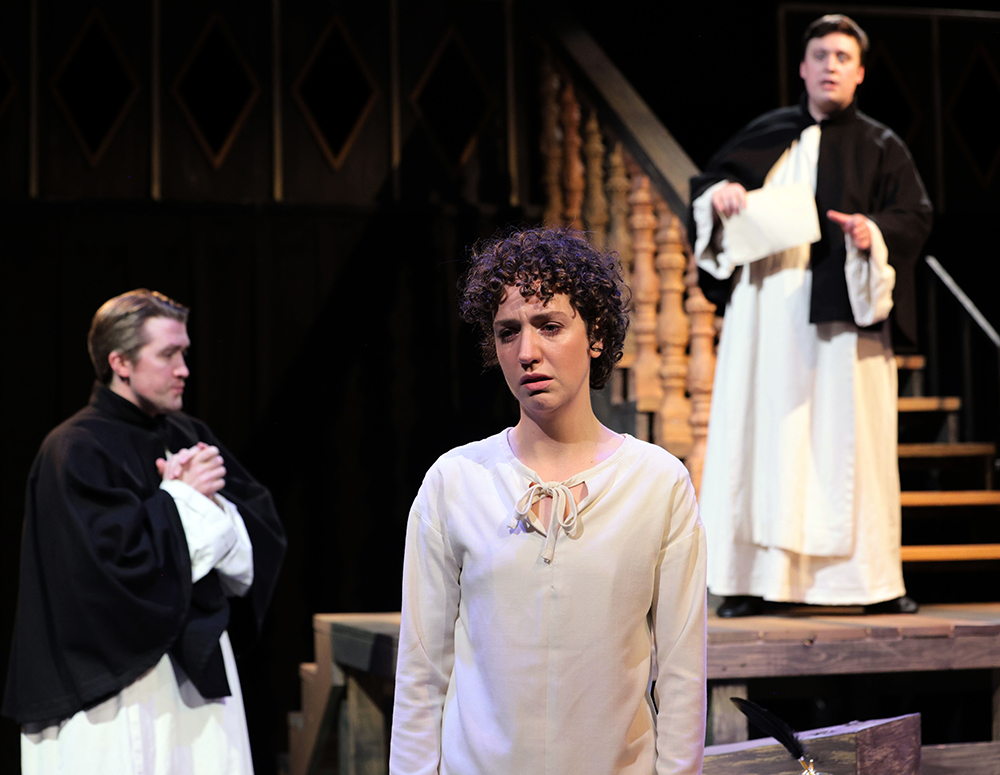he opening scenes of George Bernard Shaw’s Saint Joan, the latest production by Tennessee Shakespeare Company, may be disarmingly light for some theatergoers. Many of us, myself included, tend to imagine the story of Joan of Arc in the direst possible terms — we all know it ends with her being burned alive, after all. And the first few minutes of the play depict just that, as if to remind us what’s at stake before the narrative begins in earnest.
But then the story launches on a disarmingly light note, with the broad, jocular acting of a comedy. Two characters blow raspberries at each other. It’s a jolly romp, as local big shot Robert de Baudricourt (Austin Hanna) blusters about the lack of eggs from his hens, which, his underlings insinuate, is likely caused by the slightly touched-in-the-head farm maiden Joan (Erin Amlicke). She’s unfazed by the generalized buffoonery, her face uplifted, radiating joy, embodying the chipper, plucky optimism of a naïf.
In a sharp disconnect from the romp, Joan insists that she hears voices, and that Saint Catherine, Saint Margaret, and Saint Michael all have instructed her to lead troops against the British at Orléans. There’s an undaunted quality in Joan’s convictions (and Amlicke’s performance) that wins over the men of power, and ultimately they are swayed to send her off to an audience with the Dauphin, aka Charles II, France’s as-yet uncrowned heir apparent.
Tennessee Shakespeare Company is nothing if not resourceful, and it casts the eight actors in this production as different characters as the changing scenes demand. Thus, the Dauphin is also played by Hanna, the broad bluster of Baudricourt replaced by his effeminate take on poor little rich boy Charles. This continues the somewhat farcical tone of the opening scene, even as graver characters, like the Archbishop of Rheims (Chad Marriott), enter the narrative. Another man of power, the Duke la Trémouille, also enters the story here, yet, in the fine Shakespearean tradition of gender-swapping roles (done in Elizabethan times because women were not allowed to perform), la Trémouille is played by Sarah Sakaan.
Indeed, several women take on the visage of powerful men in this production, and none more powerfully than Lauren Gunn, who plays several characters here, most impressively the English Earl of Warwick. She brings an undeniable gravitas to her performances that at last seems appropriate to what is ultimately a tragedy.
Then, as the play proceeds, farce recedes and the entire cast rises to the occasion of the story’s inherent drama. As Joan is put on trial for heresy, we see some of the show’s finest performances, including finely wrought characterizations by Hanna as the Inquisitor and Sakaan as Cauchon, the Bishop of Beauvais. And Amlicke’s distress in the finale is all the more powerful in contrast with her unflappably jaunty take on Joan in earlier scenes.
Indeed, that may be a key to this intriguing staging of the play, as the lighthearted gives way to the tragic. The powerful ending is underscored by way of contrast with the early scenes. And, speaking of underscoring, the sound design and musical compositions by Joe Johnson foreshadow the tragedy to come. That in turn is capped off with a coda wherein a visitor from the 20th century reads the official statement of Joan’s canonization in 1920, and all the key characters step out of time to consider their role in it.
The contrasts in tone, as director Sarah Hankins astutely conveys here, are ultimately what Shaw envisioned when writing the play. As he noted in the play’s preface, “There are no villains in the piece. … It is what men do at their best, with good intentions, and what normal men and women find that they must and will do in spite of their intentions, that really concern us.”
Tennessee Shakespeare’s final two performances of Saint Joan are on Friday, April 18th, at 7:30 p.m. and Saturday, April 19th, at 3 p.m. Visit tnshakespeare.org for details.
